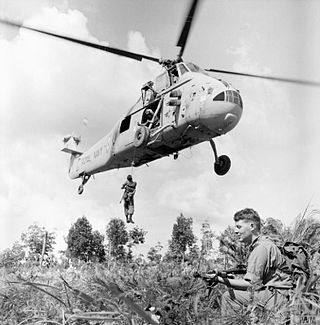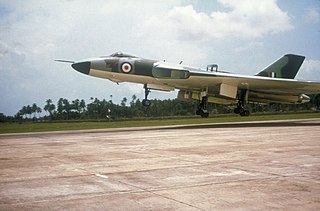
The Indonesia–Malaysia confrontation or Borneo confrontation was an armed conflict from 1963 to 1966 that stemmed from Indonesia's opposition to the creation of the state of Malaysia from the Federation of Malaya. After Indonesian president Sukarno was deposed in 1966, the dispute ended peacefully.

Claret was the code name given to operations conducted from about July 1964 until July 1966 from East Malaysia across the border in Indonesian Kalimantan during the Indonesia–Malaysia confrontation. They were instigated by the Director of Borneo Operations (DOBOPS) Major General Walter Walker with the agreement of the British and Malaysian governments. Their purpose was to seize the initiative and put the Indonesians on the defensive instead of allowing Indonesian forces to be safely based in Kalimantan and attack when and where they chose. However, it was important not to cause the Indonesians to lose face and possibly escalate the conflict, or to enable Indonesia to present evidence of 'imperialist aggression', so Claret operations were highly classified and never publicised, although it seems that some British journalists were aware of what transpired. British casualties on Claret operations were publicly reported as being in East Malaysia.

The Royal Australian Regiment (RAR) is the parent administrative regiment for regular infantry battalions of the Australian Army and is the senior infantry regiment of the Royal Australian Infantry Corps. It was originally formed in 1948 as a three battalion regiment; however, since then its size has fluctuated as battalions have been raised, amalgamated or disbanded in accordance with the Australian government's strategic requirements. Currently, the regiment consists of seven battalions and has fulfilled various roles including those of light, parachute, motorised and mechanised infantry. Throughout its existence, units of the Royal Australian Regiment have deployed on operations in Japan, Korea, Malaya, Borneo, Vietnam, Somalia, Rwanda, Cambodia, East Timor, the Solomon Islands, Iraq and Afghanistan.

The 4th Battalion, Royal Australian Regiment was an infantry battalion of the Australian Army, forming part of the Royal Australian Regiment and eventually Special Operations Command. The battalion was formed on 1 February 1964, converted to a special forces unit on 1 February 1997, and was renamed the 2nd Commando Regiment on 19 June 2009.

The International Force East Timor (INTERFET) was a multinational non-United Nations peacemaking task force, organised and led by Australia in accordance with United Nations resolutions to address the humanitarian and security crisis that took place in East Timor from 1999–2000 until the arrival of UN peacekeepers. INTERFET was commanded by an Australian military officer, Major General Peter Cosgrove.

The 3rd Battalion, Royal Australian Regiment is the armoured infantry battalion of the Australian Army, based in Kapyong Lines, Townsville as part of the 3rd Brigade. 3 RAR traces its lineage to 1945 and has seen operational service in Japan, Korea, Malaya, Borneo, South Vietnam, Rifle Company Butterworth, East Timor, the Solomon Islands, Afghanistan, and Iraq.

The 2nd Battalion (Amphibious), Royal Australian Regiment is an Amphibious Reconnaissance Battalion of the Australian Army part of the 1st Division Amphibious Task Group based at Lavarack Barracks in Townsville.

The 7th Battalion, Royal Australian Regiment was a regular infantry battalion of the Australian Army. It was originally raised in 1965 as part of Australia's commitment to the Vietnam War and it eventually served two tours in Vietnam in 1967 and 1971. In 1973, following Australia's withdrawal from the conflict, the battalion was amalgamated with the 5th Battalion, Royal Australian Regiment to form the 5th/7th Battalion, Royal Australian Regiment. The battalion was re-linked with the 5th Battalion to reraise the 5th/7th Battalion, Royal Australian Regiment in December 2024.

The Battle of Binh Ba, also known as Operation Hammer, took place during the Vietnam War. The action occurred when Australian Army troops from the 5th Battalion, Royal Australian Regiment fought a combined force of People's Army of Vietnam (PAVN) and Viet Cong (VC), including a company from the PAVN 33rd Regiment and elements of the VC D440 Battalion, in the village of Bình Ba, 5 kilometres (3.1 mi) north of Nui Dat in Phuoc Tuy Province. The battle was unusual in Australian combat experience in South Vietnam as it involved fierce close-quarter house-to-house fighting, although the majority of enemy killed was through heavy artillery and air-bombardment. In response to PAVN/VC attempts to capture Binh Ba the Australians assaulted the village with infantry, armour and helicopter gunships, routing the VC and largely destroying the village itself. Such battles were not the norm in Phuoc Tuy, however, and the heavy losses suffered by the PAVN/VC forced them to temporarily leave the province. Although the Australians did encounter PAVN/VC Main Force units in the years to come, the battle marked the end of such large-scale clashes, and ranks as one of the major Australian victories of the war.

The Battle of Sungei Koemba took place during the Indonesia–Malaysia confrontation. Involving Australian and Indonesian troops, the battle consisted of a series of ambushes launched by the 3rd Battalion, Royal Australian Regiment, along the Sungei Koemba river in Kalimantan. The ambushes were part of the wider Operation Claret which involved cross-border operations by British-Commonwealth units from bases in Sarawak, penetrating up to 10,000 yards (9,100 m) into Indonesian territory with the aim of disrupting the movement and resupply of Indonesian forces and to keep them off balance.
The Battle of Kindau took place during the Indonesia–Malaysia confrontation. Involving Australian and Indonesian troops, the battle was the third in a series of successful ambushes between May and July 1965 launched by the 3rd Battalion, Royal Australian Regiment, in Kalimantan. The ambushes were part of the wider Operation Claret which involved cross-border operations by British-Commonwealth units from bases in Sarawak, penetrating up to 10,000 yards (9,100 m) into Indonesian territory with the aim of disrupting the movement and resupply of Indonesian forces and to keep them off balance.

The 8th Battalion, Royal Australian Regiment was an Australian Army Regular infantry battalion. The battalion was formed in July 1966 as part of an expansion of the Australian Army in the mid-1960s due to the perceived threat of Communism in southeast Asia. Initially the battalion was sent to Malaysia in 1967, before later being sent to South Vietnam as part of Australia's commitment to the Vietnam War. Between November 1969 and October 1970 the battalion undertook operations as part of the 1st Australian Task Force, before being brought back to Australia. In October 1973, after Australia's involvement in Vietnam officially ended, the battalion was amalgamated with 9 RAR to form 8/9 RAR.

The Indonesia–Malaysia confrontation was fought from 1962 to 1966 between the British Commonwealth and Indonesia. Indonesia, under President Sukarno, sought to prevent the creation of the new Federation of Malaysia that emerged in 1963, whilst the British Commonwealth sought to safeguard the security of the new state. The war remained a limited one however, and was fought primarily on the island of Borneo, although a number of Indonesian seaborne and airborne incursions into the Malay Peninsula did occur. As part of Australia's continuing military commitment to the security of Malaysia, Australian army, naval and air force units were based there with the Far East Strategic Reserve, mainly in the 28th Commonwealth Infantry Brigade Group.

The Battle of Chongju, also spelled Battle of Jeongju took place during the United Nations Command (UN) offensive towards the Yalu River, which followed the North Korean invasion of South Korea at the start of the Korean War. The battle was fought between Australian forces from 3rd Battalion, Royal Australian Regiment and the 17th Tank Brigade of the Korean People's Army (KPA) for control of Chongju, North Korea and the surrounding area. After detecting a strong KPA armoured force equipped with T-34 tanks and SU-76 self-propelled guns on a thickly wooded ridgeline astride the line of advance, the Australians launched a series of company attacks with American M4 Sherman tanks and aircraft in support. Despite heavy resistance the KPA were forced to withdraw and the Australians captured their objectives after three hours of fighting.

The Battle of Long Khanh was fought during the Vietnam War between elements of 1st Australian Task Force and the Viet Cong (VC) and People's Army of Vietnam (PAVN) during Operation Overlord. The fighting saw Australian infantry from 3rd Battalion, Royal Australian Regiment attack a heavily fortified communist base camp in Long Khanh Province, while Centurion tanks providing close support crushed many bunkers and their occupants. Regardless, the VC fought hard to delay the Australian advance and although the bunker system was subsequently captured, along with a second system further south, the Australians suffered a number of casualties and the loss of a UH-1 Iroquois helicopter. With the Australians unable to concentrate sufficient combat power to achieve a decisive result, the bulk of the VC/PAVN force successfully withdrew intact, although they probably sustained heavy casualties in the process.

The Battle of Suoi Bong Trang was an engagement fought between US, Australian and New Zealand forces, and the Viet Cong and North Vietnamese Army during the Vietnam War. The battle occurred during Operation Rolling Stone, an American security operation to protect engineers building a tactically important road in the vicinity of Tan Binh, in central Binh Duong Province, 30 kilometres (19 mi) north-west of Bien Hoa airbase. During the fighting, soldiers from the US 1st Brigade, 1st Infantry Division and the 1st Battalion, Royal Australian Regiment, which had been attached for the operation, fought off a regimental-sized Viet Cong night assault. Repulsed by massed firepower from artillery and tanks, the Viet Cong suffered heavy casualties and were forced to withdraw by morning. After the attack, the Americans and Australians made no attempt to pursue the Viet Cong, focusing on securing the battlefield and evacuating their own casualties. The Viet Cong continued to harass the American sappers with occasional sniper and mortar fire, but these tactics proved ineffective, and the road was completed by 2 March.

Major General Bruce Alexander McDonald, was a senior officer in the Australian Army, seeing service in the Second World War, the Indonesia-Malaysia Confrontation and the Vietnam War.

In 1964, command arrangements changed. 99 Gurkha Infantry Brigade HQ returned from Singapore and replaced 3 Commando Brigade HQ in Kuching. 3rd Malaysian Infantry Brigade HQ arrived to take over East Brigade in Tawau, and 51 Gurkha Infantry Brigade HQ arrived from UK to command the Central Brigade area with the 4th Division of Sarawak added to it. Its headquarters was in Brunei, and there were no roads to any of its battalions. In DOBOPS, all HQ elements were concentrated in one HQ complex on Labuan. At least one of the British batteries stationed in Malaysia was always deployed in Borneo with its 105 mm guns.

The Indonesia–Malaysia confrontation began in early 1963 following Indonesia's opposition to the creation of Malaysia. In December 1964, a build-up of Indonesian forces on the Kalimantan border saw the British government commit significant forces from the UK-based Army Strategic Command and Australia and New Zealand deployed roulement combat forces from West Malaysia to Borneo in 1965–66.

Airborne forces raised by Australia have included a number of conventional and special forces units. During the Second World War the Australian Army formed the 1st Parachute Battalion; however, it did not see action. In the post-war period Australia's parachute capability was primarily maintained by special forces units. In the early 1980s a parachute infantry capability was revived which led to the Parachute Battalion Group forming in 1983 based on the 3rd Battalion, Royal Australian Regiment. In 1997, a full time commando regiment was raised that was able to conduct large-scale operations which matured during the 2000s. In 2011, 3 RAR relinquished the parachute role, with the commando regiment conducting a large-scale parachute capability.
















